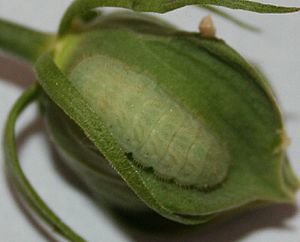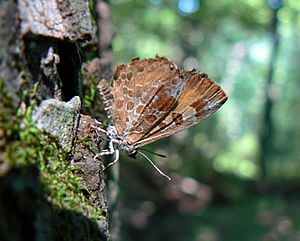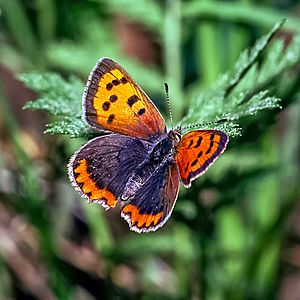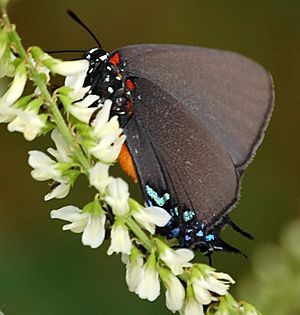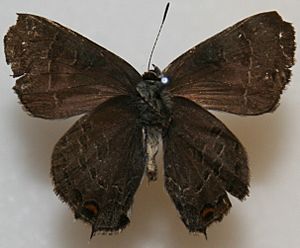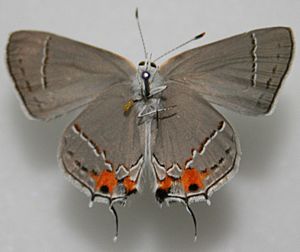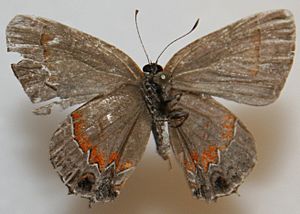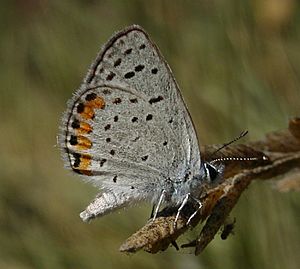List of butterflies of North America (Lycaenidae) facts for kids
List of butterflies of North America
Gossamer-wings are some of the smallest butterflies in the world! Their wingspans are usually between 0.5 and 2.0 inches (1.2 to 5.1 cm). Imagine a butterfly no bigger than your thumb!
There are about 7,000 different kinds of gossamer-wings around the globe. In North America alone, you can find about 139 species. These tiny butterflies include several groups: hairstreaks, harvesters, coppers, and blues.
Their flight styles are quite varied. Some, like the hairstreaks, fly very fast and erratically, darting here and there. Others, like the blues, have a slower, bouncier flight. You'll often see them feeding on nectar from flowers. Male gossamer-wings also like to gather at damp spots on the ground, a behavior called puddling. This helps them get important minerals.
Most male gossamer-wings find females by perching on a leaf or twig and waiting. Some males, however, fly around looking for a mate.
Contents
Life Cycle and Reproduction
Gossamer-wing butterflies lay turban-shaped eggs, usually one at a time. The larva (caterpillar) that hatches is oval-shaped with a flat underside.
Some of these caterpillars have special glands that produce a sweet liquid called honeydew. This honeydew attracts ants! The ants love to eat and collect this sugary treat. In return, the ants become bodyguards for the caterpillar. If anything tries to harm the larva, the ants will quickly swarm over it to protect their food source. It's a cool example of teamwork in nature!
When the caterpillar is ready to change, it forms a chrysalis. This usually happens hidden away in leaf litter on the ground. Interestingly, many gossamer-wing chrysalises can make faint noises. Scientists think this sound might help scare away ants that could try to attack them.
Meet the Gossamer-Wings
There are four main groups, or subfamilies, of gossamer-wing butterflies. Let's take a closer look at each one!
Harvesters (Subfamily Miletinae)
The harvester butterflies are unique because their caterpillars don't eat plants like most other butterflies. Instead, they are carnivores! They eat aphids, which are tiny insects that feed on plant sap. This makes them very helpful in controlling aphid populations.
- Harvester, Feniseca tarquinius
Coppers (Subfamily Lycaeninae)
Coppers are known for their beautiful, often metallic, orange or reddish-brown wings. They are usually found in open, sunny areas like meadows and fields.
Here are a few examples of coppers you might see:
- American copper, Lycaena phlaeas
- Bronze copper, Lycaena hyllus
- Purplish copper, Lycaena helloides
Hairstreaks (Subfamily Theclinae)


Hairstreaks get their name from the thin, tail-like extensions on their hindwings. These "tails" often have a small spot at the base, which can trick predators into attacking the wrong end of the butterfly. This gives the butterfly a chance to escape!
Some common hairstreaks include:
- Gray hairstreak, Strymon melinus
- Red-banded hairstreak, Calycopis cecrops
- Coral hairstreak, Satyrium titus
- Banded hairstreak, Satyrium calanus
- Great purple hairstreak, Atlides halesus
- Atala, Eumaeus atala
Blues (Subfamily Polyommatinae)
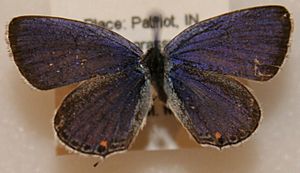
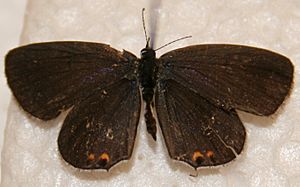
As their name suggests, many blues have bright blue wings, especially the males. Females often have more subdued colors, like brown or gray, sometimes with a hint of blue. They are typically small and delicate.
Here are a few types of blues:
- Western pygmy blue, Brephidium exilis
- Eastern tailed-blue, Cupido comyntas
- Acmon blue, Icaricia acmon
- Silvery blue, Glaucopsyche lygdamus


